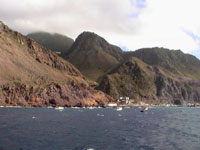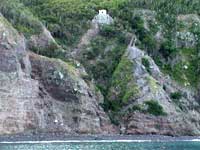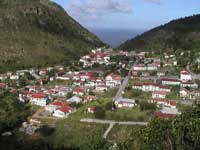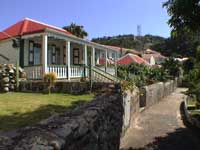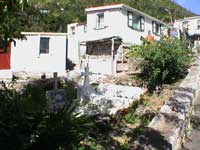
Today we’re visiting our favorite island from our earlier explorations aboard the Caribbean Explorer. We’re anchored near the Dutch island of Saba. This island is different from all the other islands in the Caribbean Sea because it has no beaches! (See December 18, 2000 journal.) Saba, which is a big volcano, rises straight up out of the sea. The island looks so old and strange that we almost expect to see large creatures roaming around – like the dinosaurs in the movie Jurassic Park. And we aren’t the only ones who think so. In 1932, the first King Kong movie ever made showed pictures of Saba as the place where King Kong lived! We’ll be exploring Saba on land today. But our ship can’t tie up to a dock in the harbor here, because there is no harbor! We use the inflatable boats on our ship to access a small dock at the edge of the water. This dock is too little for our ship. Before this dock was here, boats pulled up onto a rocky shore and people climbed hundreds of narrow, winding steps up to the top. Once a person had a big piano brought to the island. It took 12 strong men to carry the piano slowly and carefully up all those steps and into town! Fortunately, we don’t have to walk hundreds of stairs up the side of the island. A taxi is waiting to take us up to explore the island. The road we take is called "the road that couldn’t be built." The Netherlands owns Saba. Over 50 years ago, the Dutch sent some road engineers to visit Saba to see how a road could be built. The engineers saw the island’s steep cliffs and said a road couldn’t be built. After they left, a Saban man (Mr. Lambertus Hassell) thought they were wrong, so he took a correspondence course in engineering. Then Mr. Hassell and 19 of his friends built the road by themselves by hand, even though there were no cars on Saba to drive on it! The 19-mile road took them 20 years to finish (1938-1959). Now Saba has cars and the road is still the only one on the island. Our taxi driver, Cheri, takes us up the steep winding road to a small town called "The Bottom." The Bottom gets its name from the Dutch words "De Botte," which mean "the bowl." The Bottom looks like it’s at the bottom of a big bowl. Even though the area looks like the volcanic caldera, or crater, Cheri tells us it’s actually just how the volcano is formed. The caldera is plugged at the top of the volcano (Mt. Scenery), where a small rainforest grows almost 3,000 feet above the sea! Saba has 1,200 inhabitants, with about 350 people living in The Bottom. All the houses here, and everywhere else on Saba, are painted white with red roofs. Sabans are proud of their tiny island and keep their homes and villages very clean and neat. Even though everything is clean, Cheri showed us that many people have graves right next to their houses! She told us that Saba doesn’t have enough flat land to have a big cemetery, so people here are allowed to bury their dead relatives next to their houses. |
The hills of Saba are all parts of an old volcano. The top of the volcano is covered with a cloud. At the water's edge is the tiny power generating plant for the whole island. Can you find the two white houses up on the side of the volcano and the road that winds up the volcano?
Before the dock and road were built, the only way to bring people and goods onto the island was up hundreds of steep stairs. Can you find the winding stairs leading from the rocky shore up to the tiny customs checkpoint on the side of the volcano?
"The road that couldn’t be built" leads from the dock up to a town called The Bottom. In Saba, people go up to go to The Bottom!
The houses on Saba are painted white and have red roofs. People here are proud of their island and keep it clean and neat.
Can you see the three graves next to this house? Saba is the only place in the Netherlands where people are allowed to bury their dead relatives next to their homes. |
|||||||||||||||||||||
|
||||||
